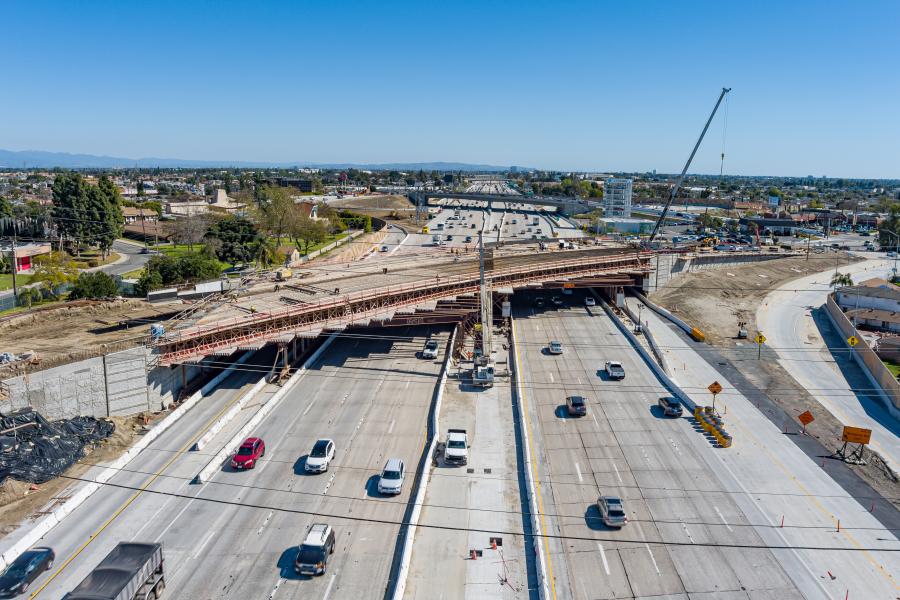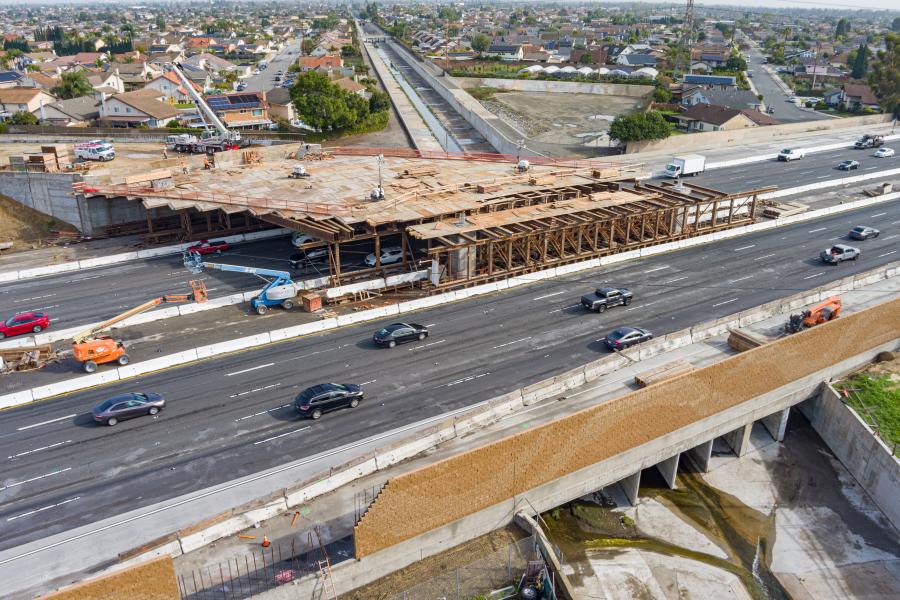The joint venture of OHLA USA and Astaldi Construction Corporation — OC 405 Partners — recently completed the massive, $2.16 billion, I-405 Improvement Project.
(OCTA photo)
The efforts of OC 405 Partners — a joint-venture of OHLA USA and Astaldi Construction Corporation — led to the completion of the Orange County Transportation Authority's (OCTA) $2.16 billion, I-405 Improvement Project, which had two new regular lanes (one in each direction) and the 405 Express Lanes (two lanes in each direction) open to the public on Dec. 1.
Officials celebrated the completion of the project with a dedication ceremony that day.
The project, which began in January 2018, was constructed in cooperation with the California Department of Transportation (Caltrans). Financing was provided by a combination of federal, state, and local funds and tolls.
The initiative was launched to improve traffic flow and reduce congestion on one of the nation's busiest highways, which on a daily basis carries 370,000 cars and trucks.
"I am immensely proud to announce the successful completion of the I-405 Improvement Project, the largest undertaking in OCTA's history," said OCTA Chairman Gene Hernandez, who also is the mayor of Yorba Linda. "OCTA's delivery of this project showcases our commitment to Orange County's voters and to improving the quality of life for everyone who lives, works or travels through this area."
The project, noted the OCTA, was a cornerstone of Measure M, Orange County's half-cent sales tax for transportation. In addition to improving travel times along this 16-mi. stretch of freeway from SR 73 in Costa Mesa and I-605 near the Los Angeles County line, it also will accommodate an expected growth in employment, population and housing throughout the region.
Project Construction
The JV added one regular lane in each direction of I-405 between Euclid Street in Fountain Valley and I-605 in Seal Beach; made improvements to streets and freeway on- and off-ramps; and reconstructed 18 bridges, many that now feature new sidewalks and bike lanes.
"Whether you commute daily, choose to use the 405 Express Lanes or opt for biking and walking through our communities, the I-405 Improvement Project is a testament to our commitment to enhancing Orange County's transportation system," said OCTA CEO Darrell E. Johnson. "I want to express my sincere gratitude to the residents, businesses and commuters for their patience during construction as we worked to create a faster and more efficient future in Southern California."
The project also created the 405 Express Lanes between SR 73 in Costa Mesa and I-605 at the Orange County border with Los Angeles County. The lanes, operated by the OCTA and located in the center of the freeway, allow carpoolers to travel for free and gives solo drivers the choice to speed up their commute via a toll.
The design joint venture was made up of Moffat & Nichol (M&N), Arup and Lochner. The three firms were each the engineer of record for approximately one third of the project.
"The I-405 project's objective is to reduce commute times for hundreds of thousands of motorists who travel the I-405 daily by adding general purpose and tolled express lanes; reconfiguring 12 interchanges to improve operational efficiency, reduce congestion-related accidents, and provide safety enhancements," noted M&N. "Safety enhancements include reducing lane weaving for through traffic, proper shoulder widths, and striping. Pacific Infrastructure I-405 Designers, a design joint venture led by Moffatt & Nichol provided full engineering services for the 16-mile highway infrastructure project, including construction support and maintenance of traffic."
The traffic management plan was based on traffic volumes, bridge construction sequencing, outreach efforts and many other factors.
"The traffic management plan was successful and adjustments were made as necessary throughout the project duration," said Jeff Mills, I-405 project manager.
"Initially, drivers were traveling too fast in the work zone," Mills said. "Over time, this issue improved as OCTA and the contractor implemented several safety mitigations, as well as a robust outreach campaign making the public aware of the 55-mph speed limit. An increased presence by the California Highway Patrol [CHP], speed radar signs that reflected the real-time speed of drivers, and positive protection between traffic and construction zones were important elements to enhance the safety of workers and drivers.
Challenges
Safely building the improvements next to a live freeway with up to 370,000 vehicles per day was one of the larger challenges, according to Mills.
"A strong safety culture and plan, along with a well thought out traffic management plan, was key to overcoming this challenge and a strong safety record was achieved," Mills said.
"Another challenge was the construction of very long bridges — and therefore, deep bridge sections — due to the skewed nature of the local street bridges crossing over the freeway," he added. "The design-build delivery method led to good collaboration between the designer and contractor to minimize impacts of the surrounding businesses and residents."
Overall, the work progressed well in spite of several significant challenges and the improvements were open to traffic on time.
"One of the more significant project issues was the discovery of archaeological resources on the project," Mills said. "Additionally, contaminated soils and unforeseen utilities posed issues as well."
Traffic was pushed to the inside of the freeway as the improvements were made to the outside of the freeway, generally behind K-rail. Challenges included unforeseen underground conditions and poor soils.
"Many areas required over-excavation due to poor soil conditions," Mills said. "The pavement type of the freeway improvements was continuously reinforced concrete pavement."
Lanes were composed of continuously-reinforced concrete pavement. Two 12-ft. lanes were added in each direction.
There were more than 50 on- and off-ramps that were reconstructed from asphalt to concrete as part of the project, according to Mills.
"Generally, the ramps were closed for approximately one month for reconstruction," he said. "Providing good sequencing of the work and viable detours were among the challenges."
There are partial cloverleaf interchanges, diamond interchanges and hook ramps, from a configuration standpoint. The reconstructed bridges typically were over 400 ft. long total and two-spans.
"Most of the 18 bridge replacements were cast-in-place concrete bridges, although there were also several precast concrete girder bridges," Mills said.
"Many bridges were worked on concurrently, consistent with the project's traffic management plan," he added. "The average one-stage bridge took approximately 18-24 months and the average two-stage bridge took approximately 30 months."
The design-builder installed drainage systems, communications systems, waterlines and sewer lines, among other items. CEG
Today's top stories



























